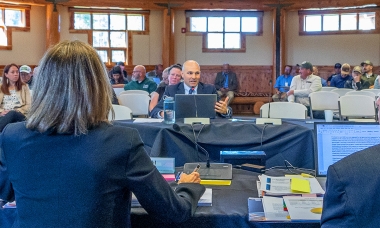
Search myodfw.com
Other than the muskrat, the water vole is the largest arvicoline in Oregon. It occurs in the Cascade Range from Mt. Hoot to Mt. Mazama and in the Wallowa and Blue mountains east and north of a line connecting Langdon Lake, Umatilla County; the North Fork Malheur River, Grant County and Cornucopia, Baker County. It is considered an inhabitant of alpine and subalpine streamsides. The water vole is active throughout the diel cycle; however, activity is least from dawn to midday, rises during the afternoon, and peaks at night, probably after midnight. It is a good swimmer and can swim
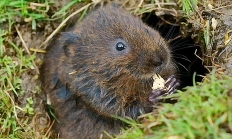
The Pacific jumping mouse is a long tailed, sleek-bodied mouse. The pelage is course. The ocherous sides are separated sharply from the tawny dorsum; the venter is white, often washed with ochre. The tail is bicolored, but not markedly so. In Oregon, the species occurs in the Cascade Range and westward to the Pacific Ocean except for southern Jackson County. These mice are largely marsh and meadow dwellers but are often found along creek banks or under ferns and weeds in the woods. In September and October, these jumping mice become exceedingly fat; in captivity, they become progressively less active
Western painted turtles need marshy ponds, small lakes, slow-moving streams and quiet, off-channel portions of rivers. They prefer waters with muddy bottoms with aquatic vegetation. Open ground for nesting and logs for basking help keep this species healthy. These painted turtles occur in the Blue Mountains and Willamette Valley ecoregions. In the Columbia Plateau, East Cascades and West Cascades ecoregions, they live only along the Columbia River. Western painted turtles are an Oregon Conservation Strategy Species in these: Blue Mountains, Coast Range, Columbia Plateau, East Cascades, West Cascades, Willamette Valley. Photo by Robert Bryce Ott

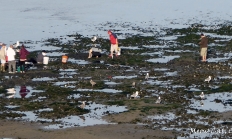
The Oregon Fish and Wildlife Commission conducts hybrid public meetings, allowing for testimony either in person or virtually. Meetings are also livestreamed from the Commission page and the ODFW YouTube channel. Per statute ORS 496.108(5), the Commission must hold one meeting per year in each Congressional District. Meeting dates and locations are scheduled a year in advance and can't always align with the local community impacted by regulation changes, another reason why they are hybrid. Meetings begin at 8:00 a.m. and proceed chronologically through the published agenda. The Commission will take a lunch recess as close to noon as the agenda

A conspicuous wader of shallow wetland habitats with a striking appearance and graceful movements. These long-legged shorebirds have contrasting black and white upperparts and during the breeding season, the head and neck turn from gray or white to a deep rust color. One of their most notable traits is a long, slender upturned bill. It is a common breeder east of the Cascades at wetlands of south central and southeast Oregon. Distribution and number of breeding birds vary annually depending on regional and local water levels and habitat availability. Regardless, most breeders occur in the western Great Basin counties of
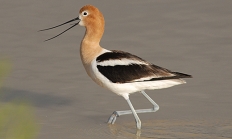
These chunky medium-small shorebirds are quite colorful in oranges and browns during most of their time in Oregon, where they are found mainly along the coast and locally in muddy areas inland. Their feeding motion has been likened to a sewing machine as flocks move slowly through shallow water and wet mud, probing with long straight bills. They are occasionally seen in marginal areas such as flooded pastures, but less likely than Long-billed to use such upland locations. They are a common to locally abundant coastal migrant, less common and more local in western interior valleys, and rare bur regular
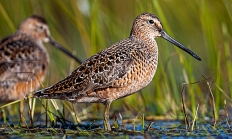
The striking tri-colored upperwing pattern on this graceful little gull is diagnostic in all plumages - a bold white triangle bordered by black outer primaries and gray back and inner wing. The Sabine's gull is most often observed flying in a steady migration over the ocean, and is seen seldomly foraging offshore. When ashore, it is found about coastal estuaries and inland lakes and impoundments picking food from the surface of the water, tidal flats, and along inland mud flats and shore edges. In Oregon, it is is a common to abundant spring and fall transient over the continental shelf
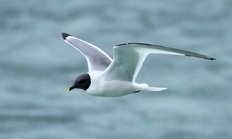
Among the least conspicuous of Oregon's birds, this inhabitant of arid country may be found in pine and juniper woodland and sagebrush shrubland. A particularly drab member of the difficult-to-identify flycatchers, the Gray flycatcher can most readily be recognized by its downward tail-bobbing motion. Other identification features include its overall gray coloration, its relatively long bill and tail, and a habit of frequently dropping to the ground from low perches in pursuit of food. It is an uncommon to locally fairly common breeder east of the Cascade summit and rare but annual along the west slope of the Cascades during

With its long, forked tail and long wings, it is the most graceful of all land birds and reminds one of the smaller terns not only in shape but in behavior. The Barn swallow has taken so completely to nesting on human-made structures that one forgets they were once restricted to caves and rock crevices. Almost every farm in the state has a pair or two nesting in an outbuilding, and very few bridges do not have a pair or two. It is the best known of the swallows. It is a fairly common to locally abundant summer resident and

A group of twittering, tiny gray birds streaming through bushes and trees and across openings surely are Bushtits. Females' eyes are pale, males' dark. They are highly gregarious except when nesting. The intricately made sock-like nest is unusually large for the size of the bird. Bushtits show a distinct indifference to humans and regularly nest within residential neighborhoods and establish foraging routs throughout many cities. They regularly take suet at bird feeding stations and visit backyard birdbaths. The Bushtit is a fairly common resident throughout Oregon except in Umatilla, Union, and Wallowa counties and at higher elevations of mountain ranges

This eloquent wren is admired for its sweet, descending, liquid notes that echo off canyon walls. It is distinguished from other wrens by its gleaming white throat set off by gray head, rusty brown underparts and back, and bright rufous tail. Appreciated as it is, this is one of our least studied birds in part due to its frequently inaccessible habitat: cliffs, rimrock and deep canyon walls. It is a fairly common but local breeder in Oregon east of the Cascade summit; restricted to rocky cliffs or outcrops. It is more dispersed after breeding season west of known breeding range

This shrew is the largest member of the genus in North America. Truly a water shrew, it swims easily both on the surface and while submerged, mostly by alternate strokes of the hind feet. When leaving the water, it literally springs from the surface. In Oregon, it occurs in the northern Cascade Range in Clackamas, Hood River, and Multnomah counties, then west in Clatsop, Columbia, and Washington counties along the Columbia River, and southeasterly from Newport through Benton, Lane, Linn, Jackson and Klamath counties. Habitats include alder in riparian zones, skunk cabbage marshes, deep, dark, red cedar swamps, floating mats
The pelage of this mouse is grayish or brownish dorsally, the venter hairs are white with lead-colored bases, and the tail is light colored. In Oregon, it occurs within the area circumscribed by a line connecting Denio Nevada; Fort Rock, Lake County; Powell Butte, Crook County; Malheur National Wildlife headquarters, Harney County; and Burns Junction, Malheur County. On a daily basis, activity begins with an intense burst during the first light to hours after sunset, and declines to almost nil six hours after sunset, then, especially in summer, increases again before sunrise. The Dark Kangaroo Mouse constructs elaborate nests with

Features: Lingcod have an elongated body with a large mouth and sharp, canine-like teeth. They are generally mottled gray or brown but sometimes green or blue. A green-colored “ling” should not be confused with a greenling. Lingcod can get 5-feet long, but those caught in Oregon average between 2- and 3-feet. Habitat: Adults like to be near rocks, inshore and to 230-fathoms deep. Young lingcod prefer the sand or mud bottoms of bays and inshore areas. Technique: Bounce some bait along the bottom with 5/0 or 6/0 hooks, a 4- to 6-ounce sinker, and 20-pound line on a stout rod
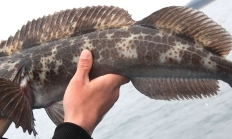
Features: Trout-like in appearance, the body is silvery in color with a bronze or dark back. They can be distinguished from trout by the forked tail and the small, down-turned mouth. Lengths run to 20-inches. Whitefish are often erroneously called graylings by many anglers. Habitat: Mountain whitefish inhabit many Oregon streams and lakes, thriving best in clear, cold water. Techniques: Whitefish tend to go for flashy flies, but are known for quickly spitting them out. Many sportsmen look with disfavor on the whitefish and often throw it away as undesirable. However, the flesh of the whitefish is firm and tasty

The pied-billed grebe is an aquatic species that breeds at the edge of open water in freshwater lakes, ponds, sluggish rivers, and marshes. When disturbed, it sinks like a submarine, rather than diving, and re-emerges with only its head above water. This is a brownish grebe with a black vertical bar in the middle of the rather stubby, whitish bill, and jet-black throat patch on both sexes in alternate plumage. It has a surprisingly loud "yelping" call within a marsh. Young have striking stripes on the head. This bird is widespread and common in Oregon. It winters locally in open

A large, long-legged wader distinguished from similar species in a flight by flashing rufous underwings and dark brown primaries. Its feet extend beyond tail tip in flight. Flocks generally consist of fewer than 50 birds on the coast. Juveniles migrate south several weeks later than most adults. After mid-November, a few stragglers are seen until late December. The Marbled godwit is a regular spring and fall migrant on the Oregon coast. Spring migration commences in early April and extends through early June on the coast. Its average arrival at the Malheur National Wildlife Reserve is April 27. Hear the call

The nasal meow of the Franklin's gull can be heard as it soars above wetlands and meadows, and colonies of this species are reported to be the loudest of all the gulls. In breeding plumage, the black hood contrasts sharply with the white breast and bright red bill. This species depends much more on insects and other invertebrates than do other gulls, and is therefore considered economically beneficial and favored by farmers. The Franklin's gull occurs in the southeast portion of the state in spring and summer, especially Harney Basin. It is rare west of the Cascades. It nests locally

This large arctic gull visits the Northwest in winter where its pale bulk often stands out in gull flocks. Finding one is a highlight of winter birding. Even at a distance the size and frosty tones of this bird can be spotted in a flock. Most Oregon birds are in the whitish first-or-second-year plumage showing a pinkish bill with sharply delineated black tip, but third-year birds and adults occur now and then, mainly on the north coast and at Sauvie Island. They are rare but regular along the coast and the Columbia River, and rare in the Willamette Valley. It

